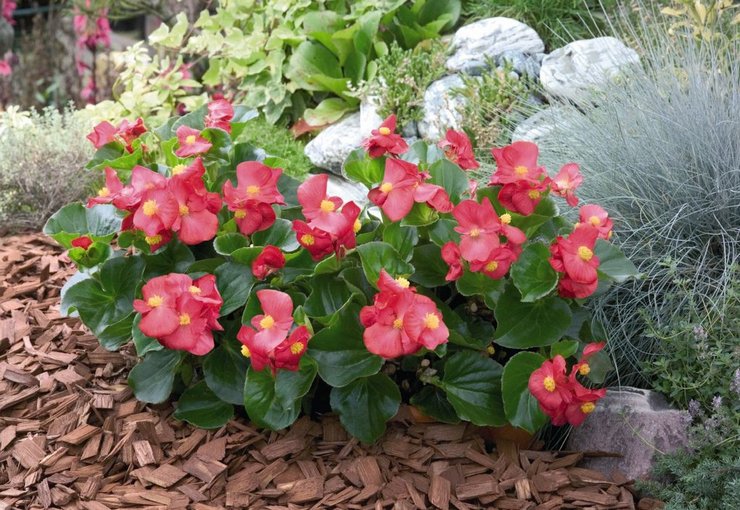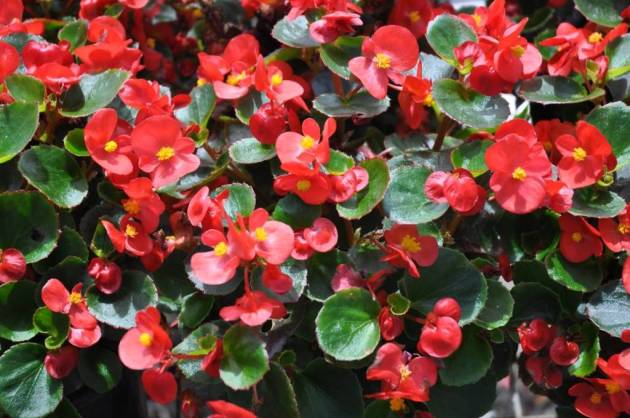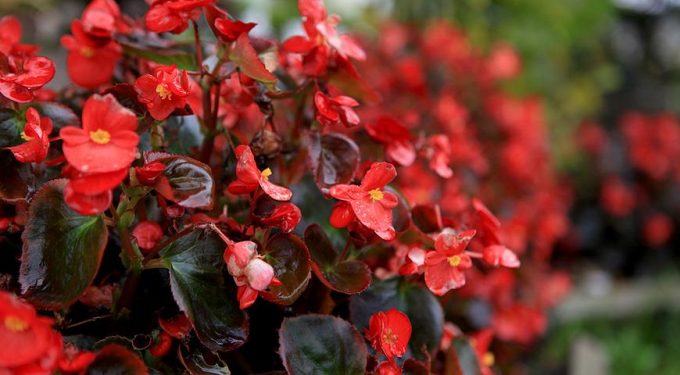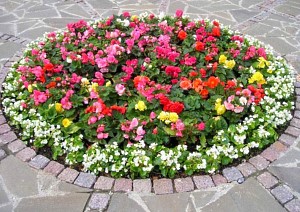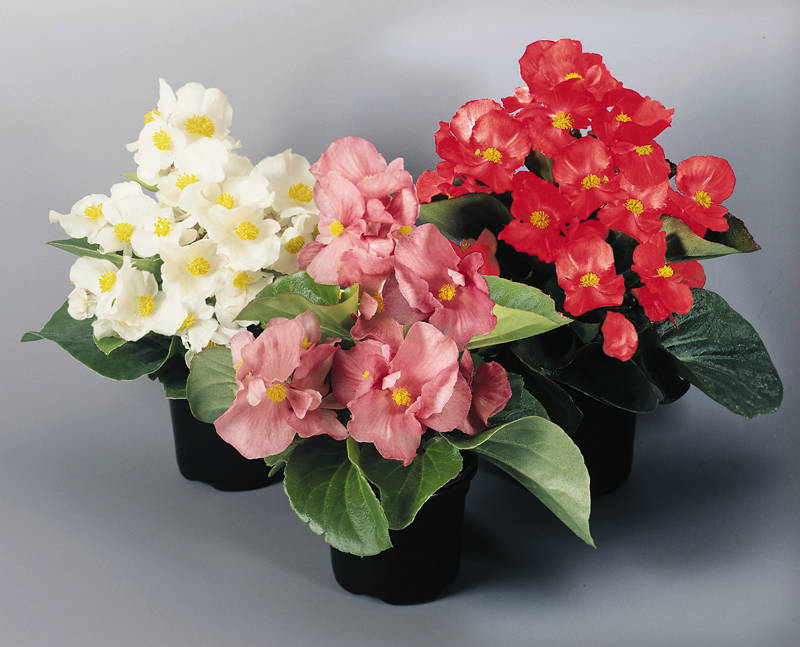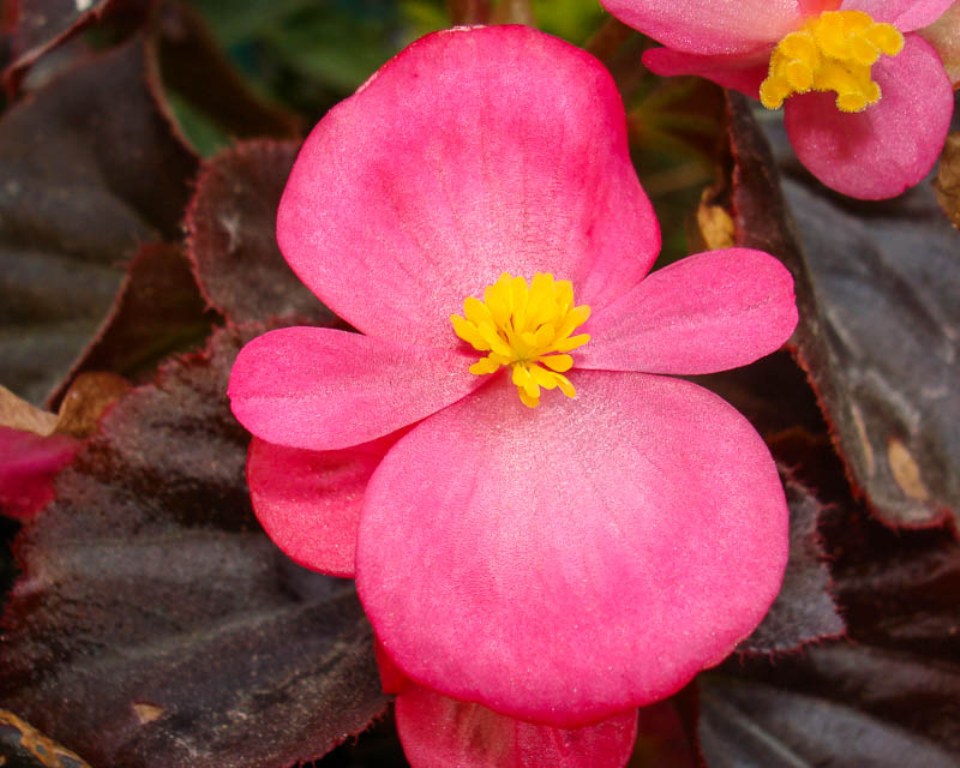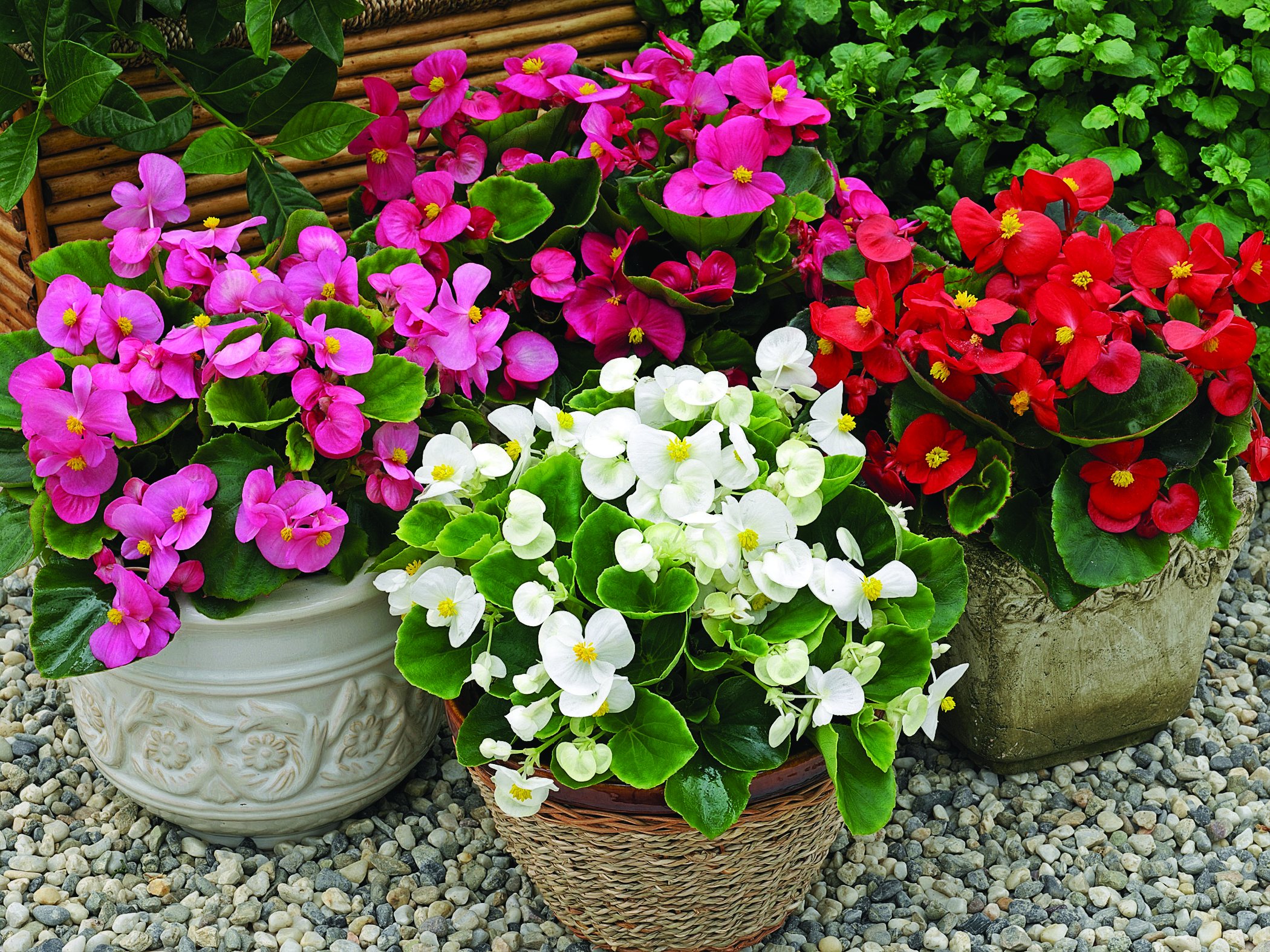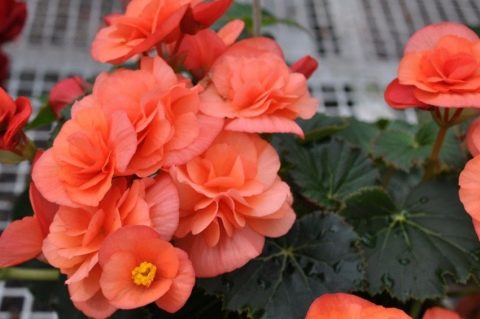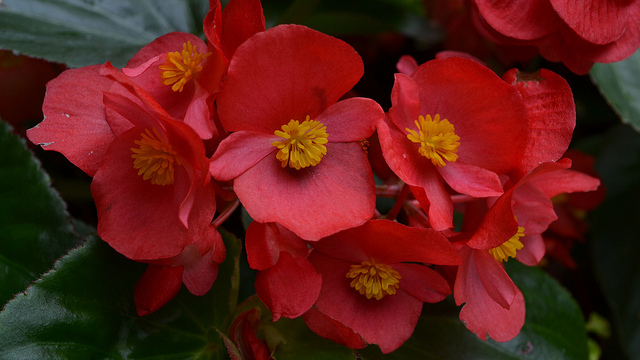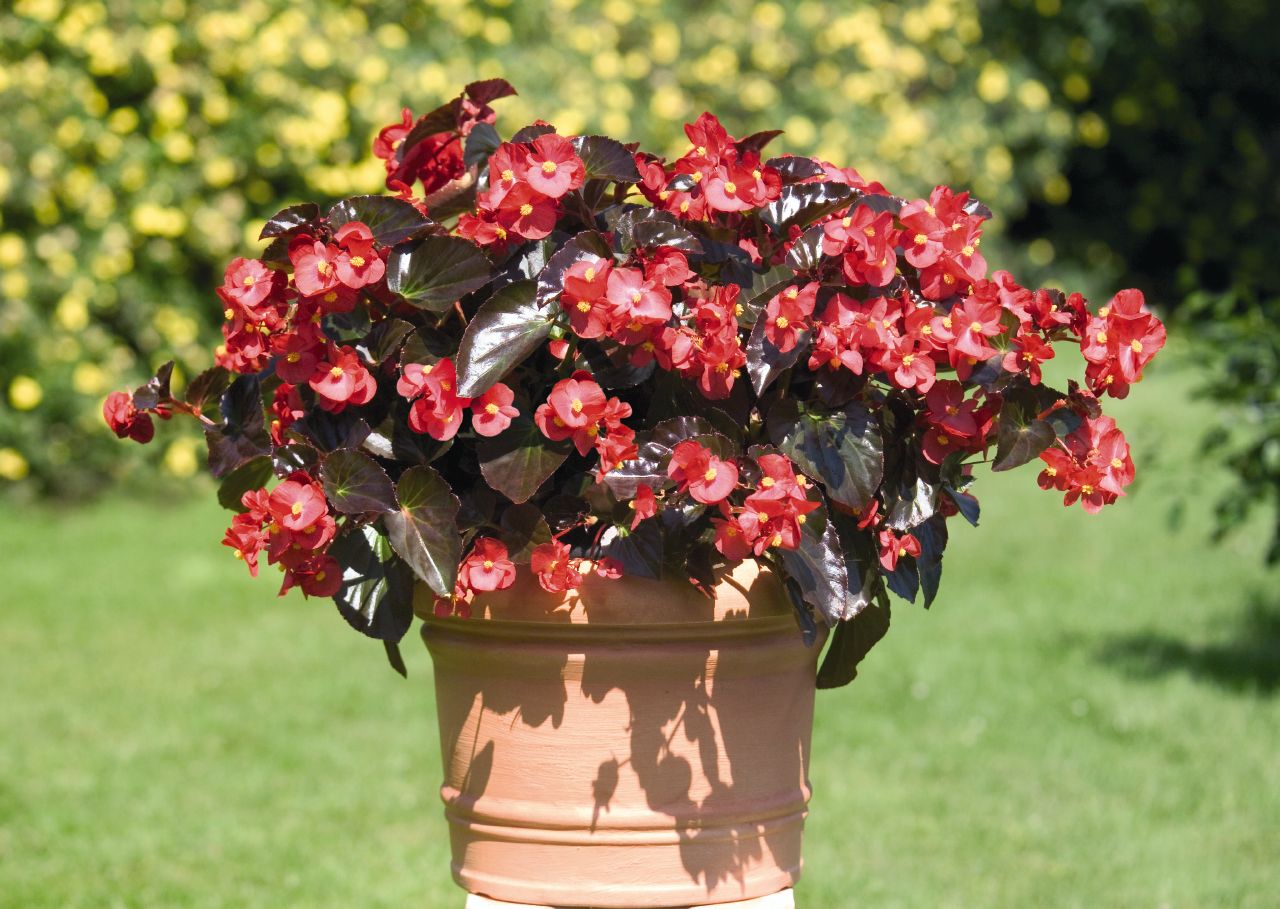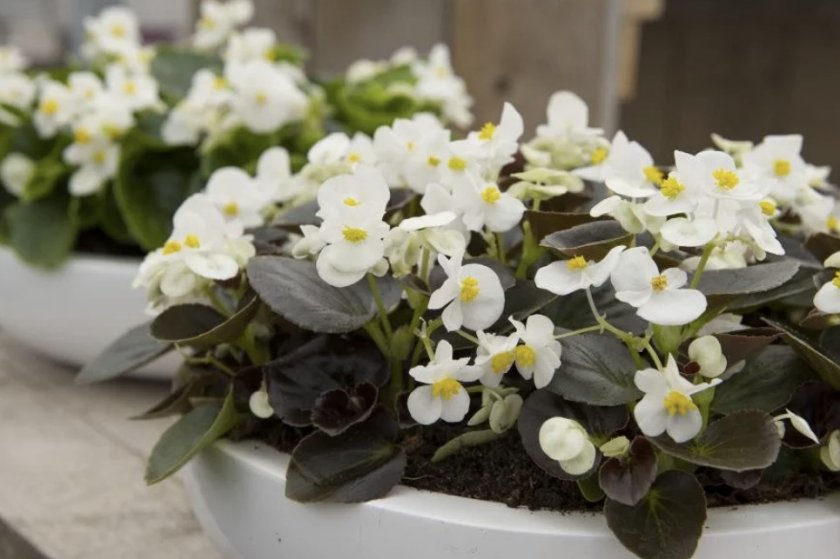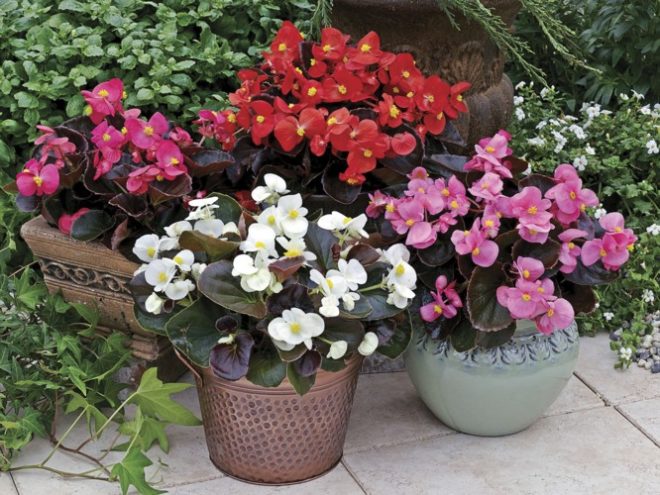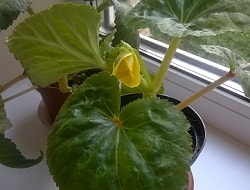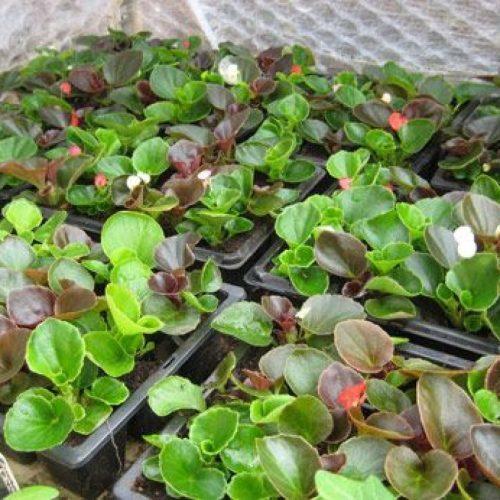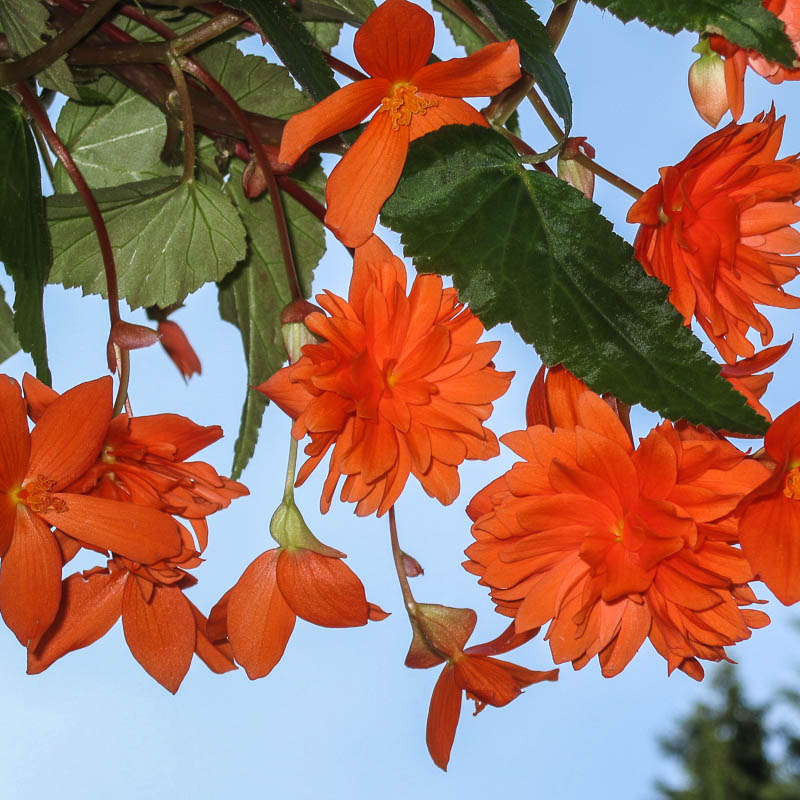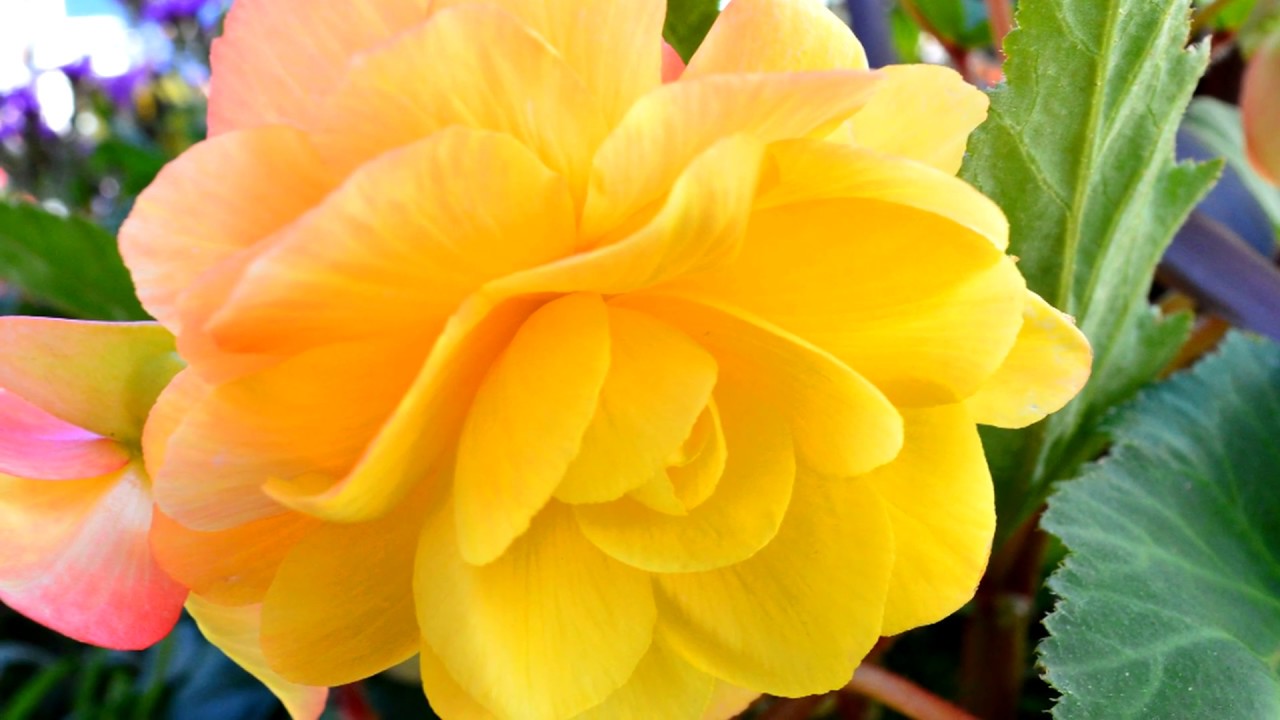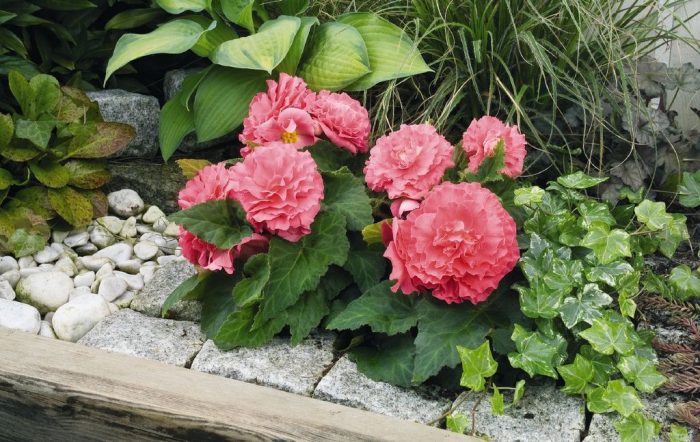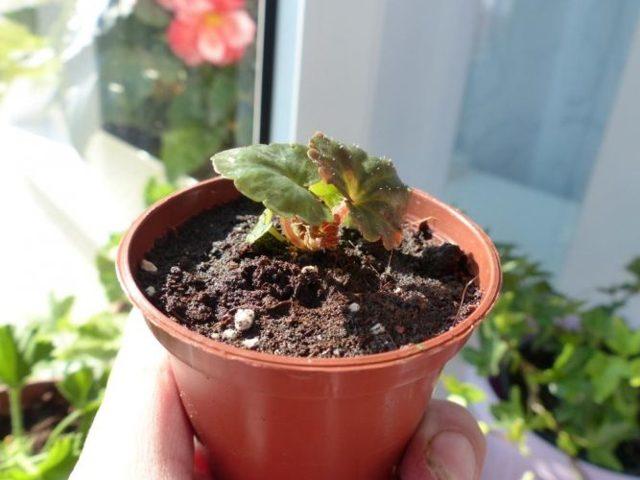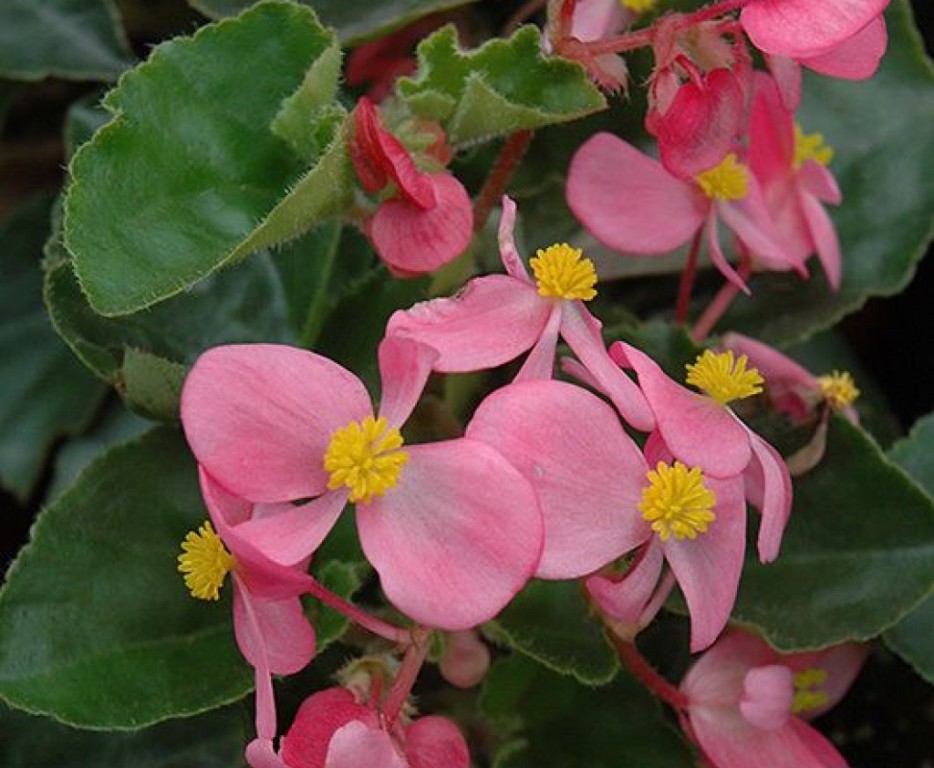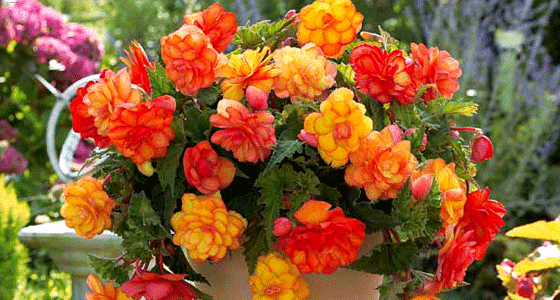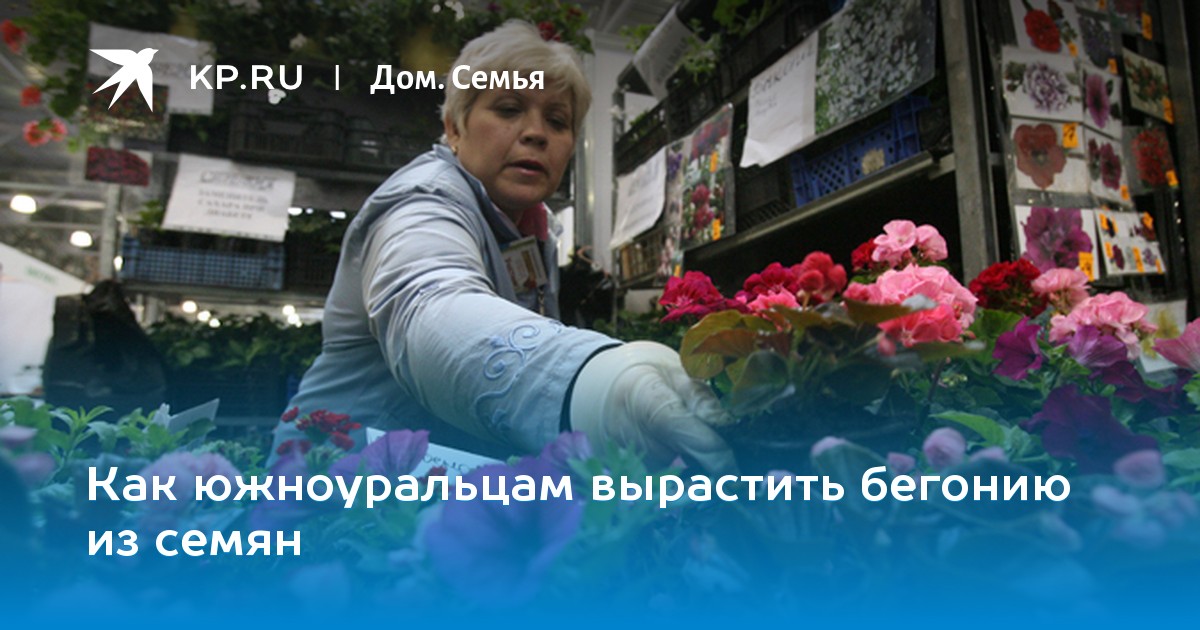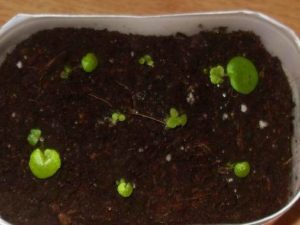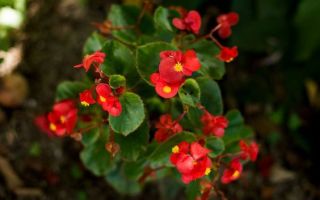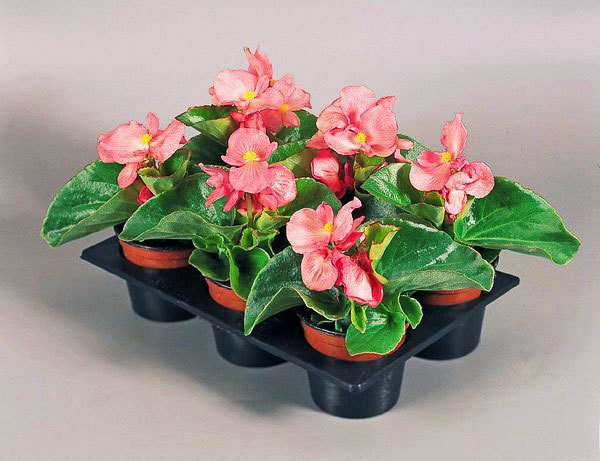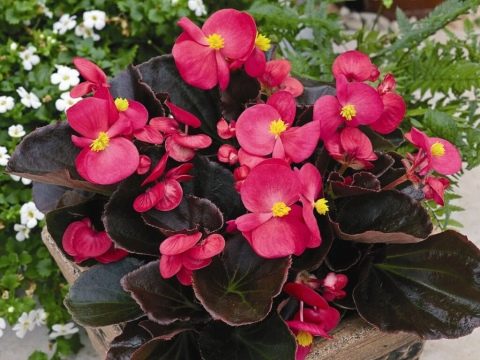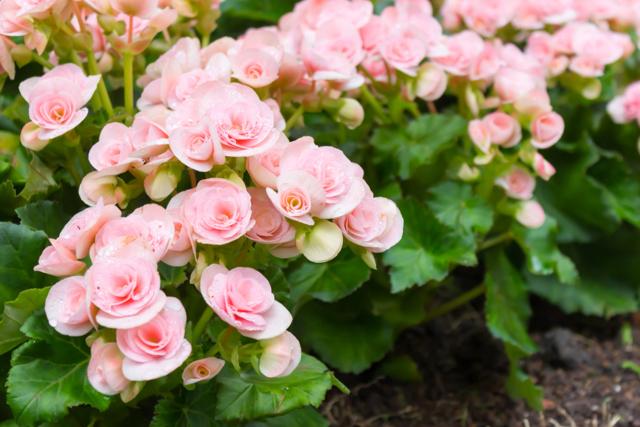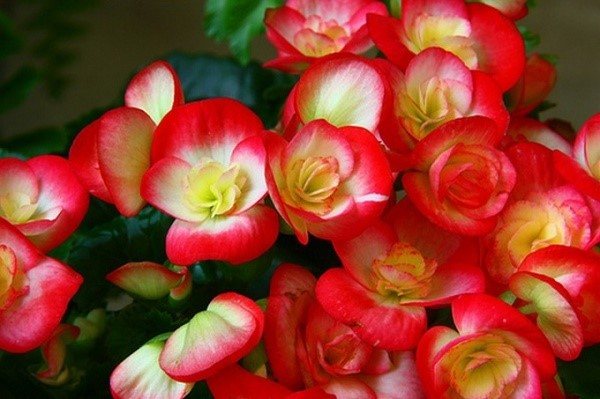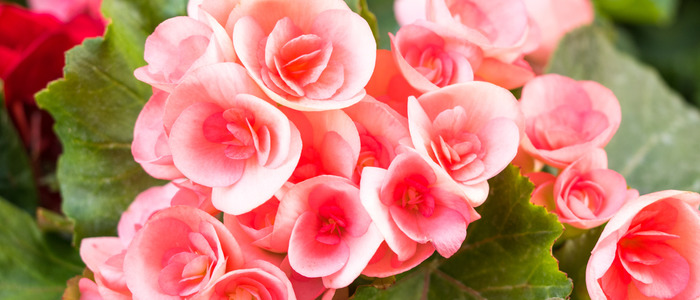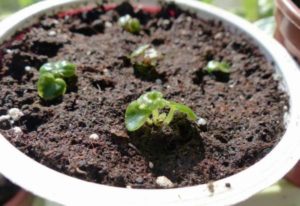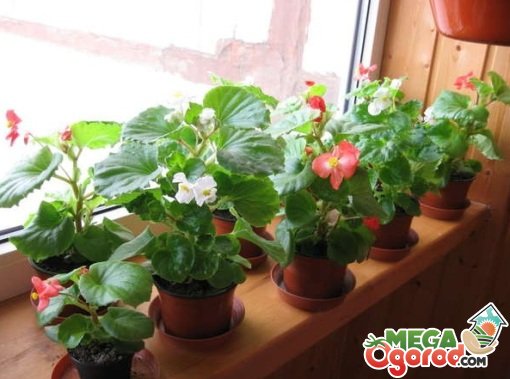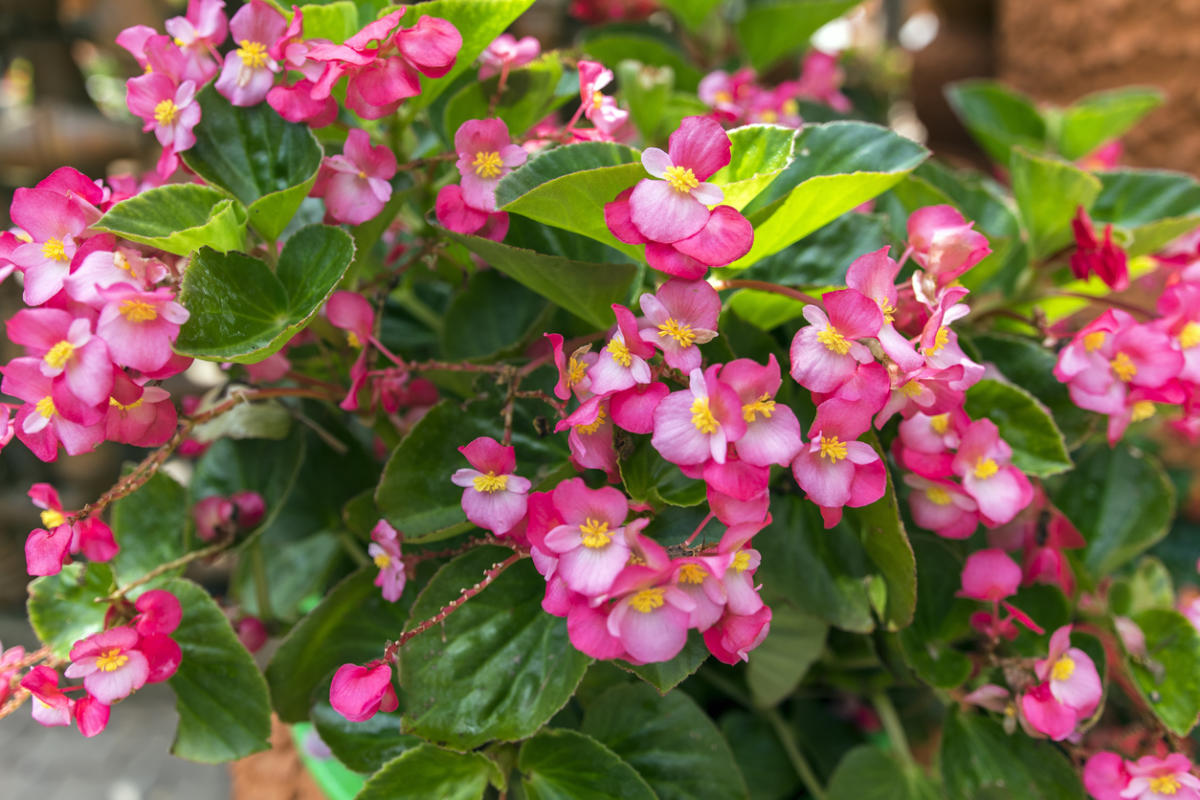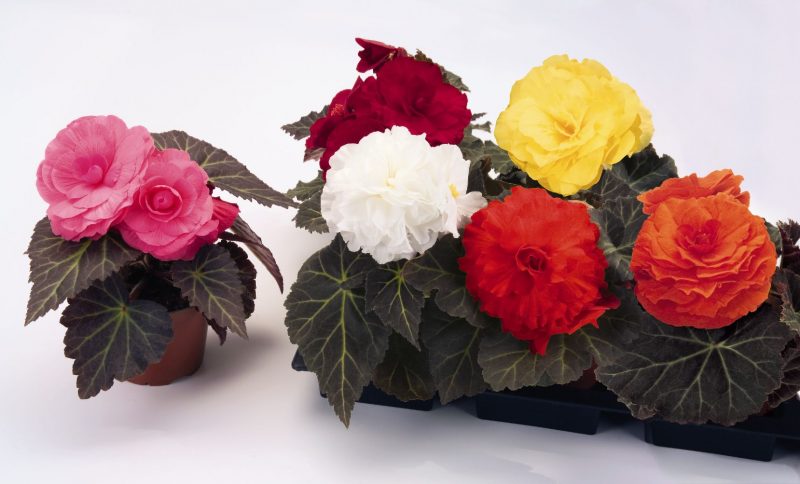Description of tuberous begonia: known varieties and their characteristics
Tuberous begonia is bred by breeders on the basis of 8-9 begonias that are common in various parts of the world. Breeding work is still going on, starting from the 19th century. To date, over 200 varieties have been created.
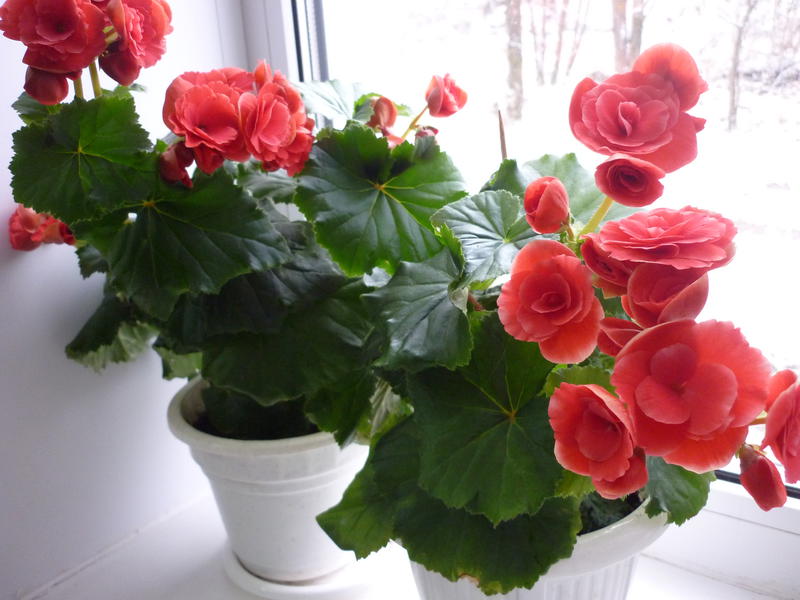
Perennial on the windowsill
Important! The main difference between tuberous begonias and other representatives of the genus Begonia is the ability to grow both at home and in the open field: in flower beds, rock gardens, in flower beds and flower boxes. There are herbaceous, ampelous, shrub varieties.
All have a developed root in the form of a massive tuber. Its diameter reaches 6-7 cm
There are herbaceous, ampelous, shrub varieties. All have a developed root in the form of a massive tuber. Its diameter reaches 6-7 cm.
Stems of some begonias are up to 80 cm tall, strong, developed green color. Leaves are fixed on them, the size and appearance of which differ depending on the variety. All have abundant, long-lasting flowering.
Flowers are also striking in a variety of shapes, sizes and colors. Outwardly, they are similar to the flowers of carnations, peonies, daffodils. In diameter, they vary from 3 to 20 cm. In ampelous species, flowers can be collected in inflorescences and are divided into male and female. Flowering begins in May and can last until October.

Flowering Scarlet variety
Thanks to modern breeding, unique subspecies are created with an interesting color of the petals, which have increased resistance to adverse environmental conditions. Some of the most common varieties of tuberous begonias include:
- Scarlet is a large-flowered terry variety. The petals are red. Feels comfortable both in illuminated areas and in partial shade. With enough light, it blooms profusely and for a long time;
- Olivia. Differs in a delicate aroma reminiscent of a rose. The diameter of the opened flowers reaches 18 cm. The petals are delicate apricot, double. The closer the petals are to the center of the flower, the smaller their size;
- Chanson. Several subspecies have been bred with different colors: red, yellow, orange, white. Flowers are collected in bunches, bloom in large quantities, they are up to 6 cm in diameter. Shoots grow up to 40 cm in height;

Party Dress Variety
- Matilda. The highlight of the variety is the delicate white terry petals with a pinkish edging, and the edge becomes brighter as the begonias grow. The flowers are large, up to 15-18 cm. Blossom until the end of September;
- Party Dress is a bright decoration of window sills and flower beds with orange petals bordered by a red stripe. Their fringed edges look like ruffles. The flowers are large, double, although they appear on compact bushes, barely reaching 30 cm in height.
How to plant seeds?
Ever-flowering begonia has very small seeds, so before planting it will be better if you mix them with sand or the same soil in which they will later be planted. Planting time, which is preferred for the earliest seedlings - January. It is in this month that active work should begin on the cultivation of such a flower as ever-flowering begonia.
You need to sow seeds in a special way, not like all seeds in dug holes. It is necessary to sow directly on the surface of the soil prepared in the boxes. The soil must first be watered and lightly tamped. It is not recommended to sprinkle the seeds with anything.
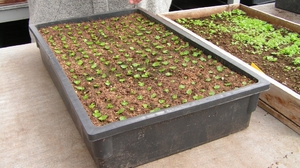 The planted boxes must be covered with a suitable size glass, which could completely protect the crops from the external influences of the surrounding space. The formed greenhouse will allow preserving the microclimate necessary for the ever-flowering begonias in it.
The planted boxes must be covered with a suitable size glass, which could completely protect the crops from the external influences of the surrounding space. The formed greenhouse will allow preserving the microclimate necessary for the ever-flowering begonias in it.
Drops may form on the glass that covers the container, which must be wiped off. If this is not done, then there is no guarantee that the seeds will germinate and not rot. To reduce the number of drops, you can put the container at an angle, then the drops will flow down the glass and, without getting on the seeds, moisten the ground near the wall of the box.There is another way to reduce humidity. It can be used before the first shoots appear. Thick paper is placed on the glass, which forms a shadow, which reduces moisture.
Begonia
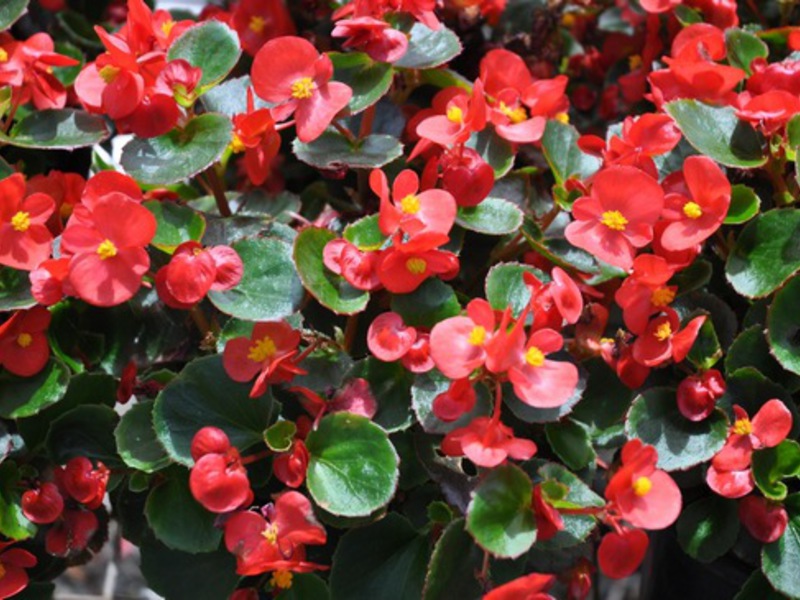
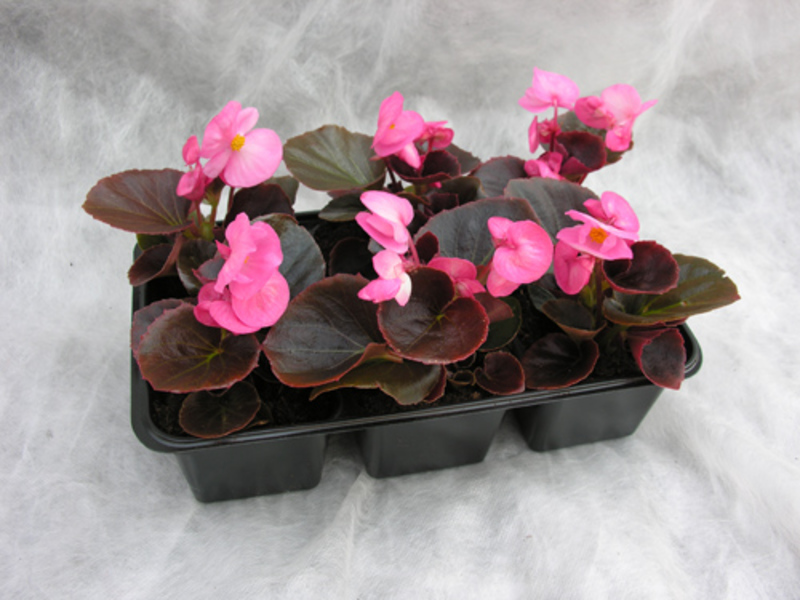
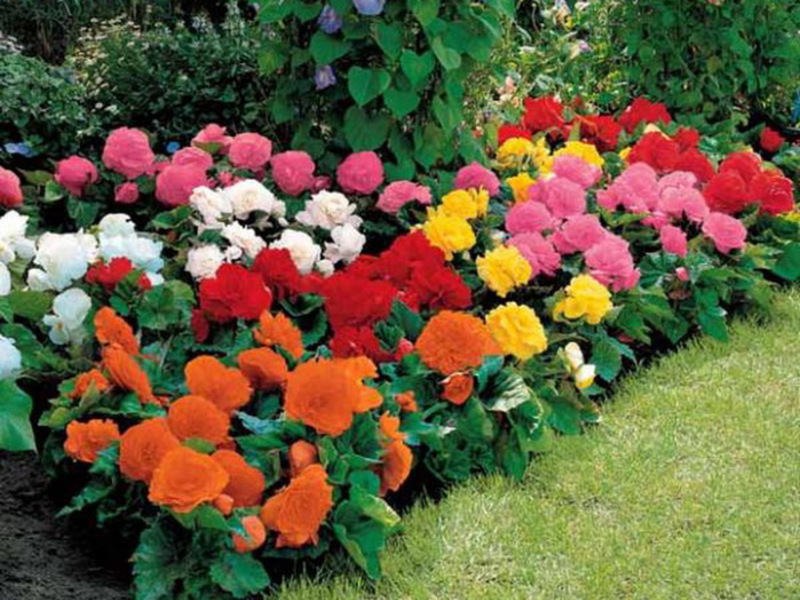
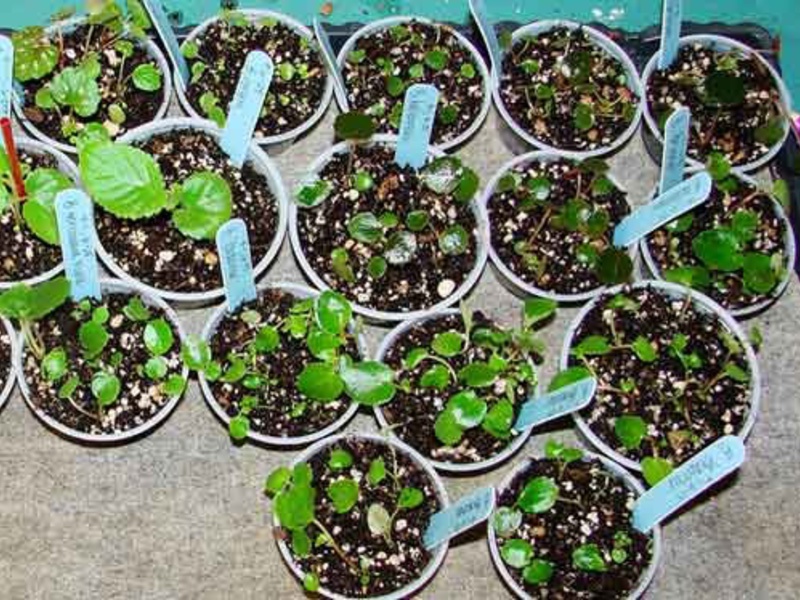
After the first sprouts of ever-flowering begonia have given, you need to spray the ground in the greenhouse from a spray bottle. You can also place the box in a tray of water for a few minutes to help the soil soak well. And if already noticeable sprouts are visible, then you need to open the glass so that ventilation takes place inside the greenhouse.
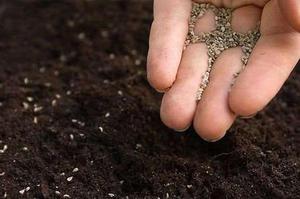 After a two week period, the indoor seedlings should be growing normally. Then you need to remove the glass so that it does not interfere with growth. The room temperature should be reduced to nineteen degrees. And sun exposure should not happen, otherwise burns may form on the leaves.
After a two week period, the indoor seedlings should be growing normally. Then you need to remove the glass so that it does not interfere with growth. The room temperature should be reduced to nineteen degrees. And sun exposure should not happen, otherwise burns may form on the leaves.
Seedling picking
After 60 days, the young seedlings are distributed in separate containers. Moreover, for the first transplant, volumetric cups or pots are not required. She does not like a lot of space, so she is transplanted several times as she grows. Plants sown in January will bloom in mid-June. By May, you can already see mature plants, with stems hanging down, on which developed leaves are located.
For transplanting seedlings, disposable plastic cups or yogurt containers are suitable, which should be thoroughly washed. At the bottom of the containers, it is necessary to make a hole and lay a 10 cm layer of drainage. The soil for replanting is the same as for sowing, but it is better to reduce the amount of sand and increase part of the sod land. The cups are not completely filled, leaving a space about 1 cm high to the edges. A depression is made in the center of the cup, where the flower is planted. After that, the temperature drops to + 18 ° C. During this period, as a rule, there is already enough natural light.
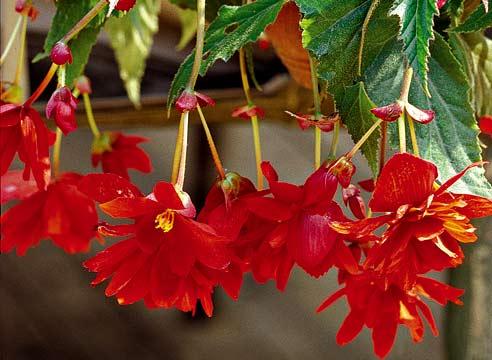
Cuttings of ever-flowering begonia
Cutting is the easiest way to propagate ever-flowering begonias. In winter, indoor plants suffer from a lack of light and dry air, so begonia that continues to bloom in the house can stretch out and shed some of the leaves. We have to resort to strong pruning, after which many cut stems remain. They can be put on cuttings
Cuttings root quickly and easily. It is advisable to slightly dry the cut site, pinch off and shorten part of the leaves. Roots appear even without the use of root stimulants.
The stalk can be planted vertically or obliquely to the soil surface. A layer of sand prevents decay. Rooting works best under a glass jar or the top of a plastic bottle (with a lid), a plastic bag, etc. The landing container is placed in a warm, bright place where there is no direct sunlight.
Cuttings can also root in a jar of water, but they often rot. Landing in the ground is not so risky.
Some amateur growers successfully cut leaves of ever-flowering begonia, taken with a "heel" from a small piece of the stem. They even take root in water.
Growing from seeds - begonia conquers the world
Decorative and ever-flowering - these are the varieties that can be grown from seeds in our time. Sowing them should be done in February or early March. This is the most favorable period for this process. Experts have come up with a rather interesting way of uniform sowing - they simply mix small seeds with sand. Prepared in this way, they can be sown in a small tray.
How to grow begonia from seeds - step by step diagram
Step 1: Prepare the land for sowing
Earth is poured into a special tray. The soil, like the seeds, is best disinfected with a weak solution of potassium permanganate. The soil can be purchased at the store or you can take peat, sand and earth for these purposes (1: 1: 2).
Step 2: sowing
The seeds are mixed with sand so that they are sown evenly in the tray.Next, pour a small amount of water, and then cover the container with seeds with glass and wait for the shoots to appear. In this case, the temperature in the tray should be above average - about 25-27 degrees Celsius.
Step 3: seedling care
After the shoots have appeared, the temperature is lowered to 19-22 degrees Celsius. Simultaneously with this, the first picking (transplanting) process is carried out. So, for the first time, the plant is transplanted in a small container (cups can be used) to stimulate the formation of the root system. The next time you need to carry out this procedure about 2 months after the previous one.
Step 4: transplant into small pots
Transplanting must be done carefully so as not to damage the root. It is best to take a small pot at this stage.
Later, when the plant gets stronger, you can transplant it into a pot of regular size. That, in fact, is all - growing flowers at home is not such a difficult process!
Seed begonia and other breeding methods
It is possible not only to grow by seeds - begonia can also propagate by cuttings, as well as dividing tubers. However, the first option described in the article (from seeds) is the most effective and allows you to achieve the desired result. Therefore, in order for you to know how to grow begonia from seeds, we will give some tips.
- It is better to buy begonia seeds in bags - there are a lot of them, and besides, this way you will definitely not lose them on the way.
- If you decide to buy small seeds, then it is better to take them in granular form. This will make it much easier to land in the ground.
- If you sowed seeds in the spring, then in the summer you can wait for flowering.
- It is not required to bury the seeds deep in the ground - it is necessary to sow the seeds on the surface of the soil.
- It is better to water the seeds not from a watering can, but from a spray bottle. Remember that begonias need soft water.
- The tray itself is best kept on the windowsill - begonia loves sunlight.
- Covering the grown seedlings with glass, you actually create greenhouse conditions for the plant.
How to properly care for begonia
Make sure the glass covers your begonia tray until the seedlings are firm. Considering that after some time it will need to be transplanted, the plant should be gradually accustomed to normal temperatures. For this, the sprouts are periodically ventilated. As for watering, you can water both through the pallet and from above.
Those who have already been involved in the propagation of begonias know that it is necessary to carefully monitor the growth and development of this flower. The leaves should open completely, and the seeds should shed their shell. If there are problems with this, the plant may even die. Make sure that both the seed coat and the soil do not dry out. If you prefer tuberous propagation, then begonia will bloom earlier - at the beginning of summer.
Plant growth also depends on the type of soil. So, begonia loves fertile soil, organically saturated with trace elements and with a low pH level. Do not forget about caring for indoor flowers in winter. The plant should be prepared for cold weather - for this, you should water the flower less and cut the begonia a little. Already in the next season, it will be necessary to water the flower more often in the spring.
We wish you to grow the most beautiful flower and may begonia please you with its flowering for many years!
Growing begonias by seeds
The technology of growing begonias from seeds differs from the well-known methods of growing seedlings for flowers, since the seeds of this plant do not look like ordinary seeds from flower boxes. Begonia seeds are very small, they look more like dust than balls. Even poppy seeds seem large in comparison.
Preparing the seedling container
It is very important to choose the right container for the seedlings so that they are strong and healthy. She must be:
- compact size;
- shallow.
For growing begonia seedlings, the following containers are suitable:
- Seedling containers available from garden stores.
- Shallow wooden crates.
- Peat tablets.
- Plastic cake molds.
In such a container, it is convenient to care for the seedlings and carry out a pick.
Soil selection
It is from the soil that the plant receives all the necessary nutrients. The best results can be achieved using a primer:
- slightly acidic;
- neutral.
This soil is sold in garden stores, but you can prepare it yourself. To do this, take:
- 2 parts of leafy land obtained from the decay of a large amount of foliage;
- 1 part peat;
- 1 part sand.
All components are thoroughly mixed and sieved through a sieve to remove excess lumps and impurities.
Seed preparation
Begonia seeds are so small that it is very difficult to work with them. However, knowing some tricks, even a novice gardener at home can cope with this.
Due to the small size of the seed, it will not work to soak and disinfect. Therefore, it is necessary to disinfect the substrate.
Therefore, it is necessary to disinfect the substrate. Can:
- steam on a steam bath;
- ignite by placing the soil in the oven for half an hour at a temperature of 150 degrees;
- pickle by treating the mixture with a strong manganese solution.
It is better to buy seeds of the company that you or your friends already know.
Sowing seeds
Begonia seeds are placed on the surface of the soil in pots; it is not necessary to cover them with earth on top.
To evenly distribute the seed over the surface of the ground, place an even, small layer of snow on top, and sprinkle the seeds on it. When the snow melts, the seeds will spread naturally on the soil.
If the snow has not been used, after sowing the seeds, the soil must be moistened with warm water using a spray bottle. In a container with sowing, it is necessary to create a greenhouse effect, for this it is covered:
- glass;
- film;
- plastic cap;
- package;
- wet gauze, etc.
This shelter is removed after the seedlings appear on the surface of the earth. After about 2-3 days. Crops must be kept in a room with an air temperature of 23-25 ° C until germination.
Growing in peat tablets
If peat tablets are used for sowing seeds, then it is better to buy granular seeds. Such sowing is much easier to carry out, moreover, there is no need to prepare containers and soil, and in the future to dive seedlings.
Step by step technology:
- Peat tablets are placed in a tray and filled with water at room temperature so that they swell and increase in size.
- The granulated seeds are spread in the middle of the tablet without pressing the soil into the body. One tablet contains 1 granule.
- From above, the seed is moistened with warm water from a spray bottle, since there will be little moisture in the peat tablet.
- To create a greenhouse effect, the seed tablets are covered with a plastic container, bag or glass beaker.
- Watering plants must be carried out regularly through the pallet so that the peat does not dry out. To do this, use a spray bottle so as not to pour too much.
- The tablets are kept in a room with an air temperature of no more than 20 ° C.
Good quality seeds should germinate within 7-10 days after sowing, some varieties - after 2 weeks.
Next, it's worth talking about why the seeds don't germinate. Let's explain the most common reasons that affect the germination of seed.
1 Planting seeds
To enjoy the blooming of begonia during the summer season, it is recommended to use the seedling method. Seeds must be sown in the ground and wait for sprouts to appear. It is better to carry out sowing from the end of January to April - the more exact time depends on the cycle of culture development. If it is necessary for flowering to begin as early as possible, it is recommended to start planting at home in the winter.In this case, by the time the seedlings are planted in open ground, the root system will be sufficiently developed, and the flowers will be able to quickly adapt to new conditions.
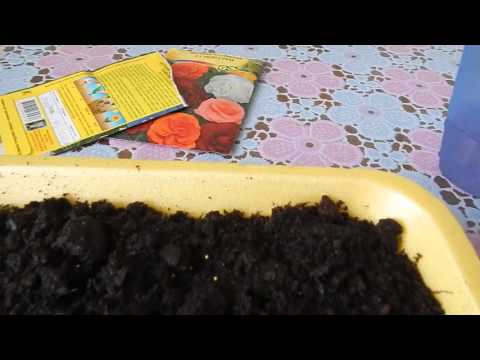
When choosing the time for planting begonias from seeds, it is necessary to take into account certain features of individual species and varieties. Sowing the ever-flowering begonias early will result in the seedlings being too overgrown by the time they are transplanted into the open field. It is much more difficult for such a plant to adapt. In the future, it will lose its decorative effect. This is because the flowering period will start too early and the number of buds will be less than expected. It is better to sow this type of plant in February.
As for tuberous begonia, it is best to plant it as early as possible - in mid-January. Then, by the time of transplantation, the leaves will have time to form normally. The tubers will have time to grow up to 3 cm in diameter at the time of transplanting into open ground. But this applies only to such varieties as ampelous begonia.
Another important point is the selection of seed. It must be of high quality. The following factors should be considered:
- 1. Terms of packing. Better to choose fresh seeds that were harvested this year. Gradually, the seed loses its germination capacity.
- 2. Type of seeds. It is much more convenient to plant seeds of granular type in peat tablets. They have a dense shell, which consists of nutrient components. Because of this, they are much larger than regular seeds. But the latter are much more convenient to sow in containers for seedlings.
Sowing is necessary as follows:
- 1. Prepare peat pots. If you use them, you will not have to pick in the future. Such a tablet is peat, pressed by a certain method and covered with a special net. The advantage of the device is that the substrate is moisture and water permeable. The composition will retain moisture, but will prevent fungus from developing.
- 2. Soak tablets in water before sowing seeds.
- 3. Put the seed into a tablet and sprinkle with water.
- 4. Cover the tablet with plastic wrap to maintain the optimum humidity level. From time to time it is necessary to water the seedlings through the pallet - the tablet should not dry out.
Begonia is also grown in ordinary containers. This can be done as follows:
- 1. Place a drainage layer on the bottom of the box - expanded clay, pebbles, gravel, etc.
- 2. Sprinkle the substrate on top.
- 3. Moisten the soil.
- 4. Place the seeds every other day, spreading them evenly over the entire surface.
- 5. Cover containers with glass or foil.
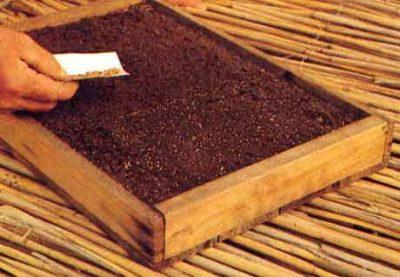
It is not recommended to water the grains immediately. The temperature must be maintained at 24 C. The container must be in a well-lit place. The first shoots will appear in 10-20 days, but sometimes it takes more time.
How to grow ever flowering begonia?
When growing this beautiful flower, you need to follow some rules: despite the photophilousness of begonia, placing it in the open sun is contraindicated, as well as hitting the flower with sunlight. This is especially dangerous during begonia flowering periods. How to grow ever-flowering begonia correctly, and what temperatures are needed for good growth and flowering of the plant?
Planting site and soil
On this topic:
BACK
FORWARD
1 in 65
Begonia will be grateful to you for a sunny, but shaded place in the summer heat. Only with the shade you need to be careful, since from a lack of light, the stems of the plant can stretch, lose their decorative properties and color of flowers. The begonia loves soil fertile and loose, enriched with humus, with a weakly acidic reaction (PH 6.2).
On soils with a high alkali content, it will grow poorly, possibly due to chlorosis or other diseases.The soil layer should be loose, because begonias have a superficial root system, which is why they like to use this plant for landscaping rocky hills. Looking at the photo of ever-flowering begonia, you immediately want to get this plant in your garden. She is so attractive.
Fertilization and watering
If the summer turned out to be dry, begonias need to be systematically watered. It is better to water it in the early morning or with the onset of coolness in the evening. The water should already be settled and soft. Watering is moderate and it must be taken into account that begonia does not like stagnant water and also dry out the earth.
Caring for the ever-flowering begonia is simple and does not take much time, and the flowers of this beautiful plant will cheer you up with their bright colors. Most importantly, do not forget to pamper her with fertilizers for flowering plants containing minerals, loosen the ground and remove weeds once every 14 days.
You need to start feeding as soon as the buds appear. And if there is a desire to keep the ever-flowering begonia until the next warm season, the mother plants of this plant should be transplanted into pots and brought into the house for wintering even before the onset of cold weather. Ever-flowering begonia at home will delight with its flowering until spring, if you allocate it a well-lit place and do not forget to water.
Propagation of begonias with ever-flowering cuttings
Open field begonia is cut in summer. For a growing house, the beginning of spring is chosen.
Cuttings:
- young leaves of ever-flowering begonia with a sharp knife are cut from the stem in order to facilitate the process of rooting growth;
- the cutting is placed in a moistened substrate and covered with polyethylene. It is also possible to place a strong and ripe leaf of ever-flowering begonia in a container of water.
In order for the ventilation process to take place, it is necessary to make holes with a knife in the plastic wrap of the greenhouse. A mixture of sand and expanded clay with perlite or moss is suitable as a substrate. After 14 days, the cuttings develop roots in a well-moistened soil. After another two weeks, the rooted begonia cuttings, freed from the film, should be transplanted into separate containers. Further, care takes place according to the technique of growing begonias from seeds. During transplanting into open ground, the seedlings need to be deepened into the ground 2 cm below the level of its growth in a pot.
Description
Begonia came to us from the tropical countries of South America; it was included in the single European register of plants back in 1821. Until now, begonia has experienced popularity several times, sometimes it was forgotten. Now the plant has a large number of different species and varieties, they have bred stems with large and double flowers, which look very impressive.
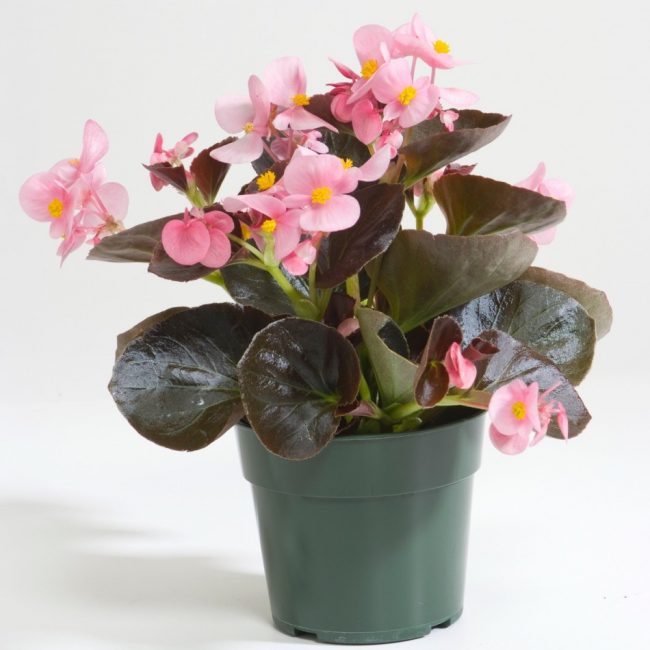
Senator Pink F1
But no less popular among florists are classic varieties with a large number of subtle flowers collected in a brush. For gardening on the street, more simple species and varieties are used, terry and large-flowered plants have taken root more as indoor plants, but if desired, they can also be grown in a flower bed near the house. Care for all species and varieties will be identical, without much difficulty and long swarming.
Ever-flowering begonia is a low plant with herbaceous stems. The leaves of the stem are usually solid, resilient, have a slight waxy coating, and are attached to the stem on a small petiole. The color range of leaf plates is varied, depending on the variety, the stem can have bright green, pinkish, brown, burgundy, dark green leaves. The foliage will vary depending on the species and varieties, almost each of them has a unique color and shape that is characteristic of this particular stem.

Ever-flowering begonia
Flowers are usually collected in racemose inflorescences, their colors can be very diverse: from snow-white to bright red. Coral and pale pink varieties with double flowers are especially appreciated.Each species will have a different number of flowers in the brush, some large-flowered only 3-4 buds, simple ones on one inflorescence can hold up to 20 small buds
It is due to the brush that attention is drawn to the flowering of the plant, insects will not be able to notice a small, nondescript flower among the variegated foliage
All ever-flowering begonias are divided according to the height of the trunk:
A feature is faster adaptation to a new place during propagation by cuttings, sowing with seeds from a special store will allow you to get a clean variety. Under the conditions of the street, the bole is pollinated and after 5-7 years it can be reborn into a taller plant.

Eternal Bronze
Regardless of the height of the adult plant, each of the described varieties is excellently grown indoors. Their decorative characteristics will be an excellent decoration for both a residential building and office windowsills. Many are used for landscaping in public places: shopping centers, entertainment complexes, cafes and restaurants.
Begonia is also recommended in childcare facilities, this plant will not harm children in kindergarten and schoolchildren, they will be happy to take care of the boles. Begonia will respond by purifying the air in the room, saturating it with oxygen, will delight the eye with variegated foliage, abundant and long flowering.
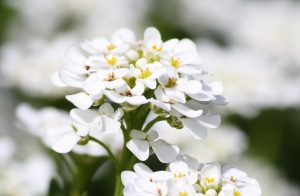
Alyssum: species and varieties of plants, sowing seeds in open ground and caring for a rainbow carpet on the site (130 Photos) + Reviews
Diseases and pests
Eternal begonia (and other varieties too) practically does not get sick if you take care of it correctly.
-
- If the begonia begins to dry out and become covered with brown spots, the buds fall off - the point is too low humidity. High humidity causes root rot.
- If the leaves began to turn pale and rot, it is a matter of excessively abundant watering.
- Yellowing of the leaves indicates a lack of light or nutrients.
- Powdery mildew appears due to stagnant water in a pot, or when the soil dries out. It is characterized by the appearance on the leaves and stems of a gray-white bloom, tiny ulcers and cracks.
- The greenhouse whitefly appears in conditions of high humidity and, having settled on leaf plates, begins to actively suck out cell sap. The leaves lose color, begin to dry out and curl. A solution of laundry soap (40 g per 10 liters of water) will help to cope with the pest.
- Gall nematode causes the appearance of bulges and growths on the roots, prevents ever-flowering begonia from growing further. Remove damaged areas and treat the plant with Heterophos solution.
- The soft false shield settles inside the shoots and leads to the drying out of the plant. If there are not very many pests, clean them by hand using a soft toothbrush, and then spray the culture with garlic infusion. With extensive damage, begonia cannot be saved.
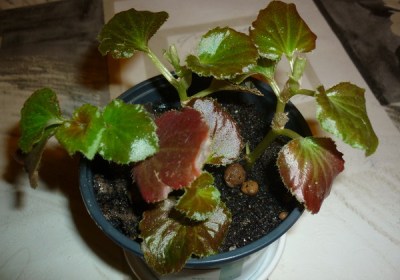
- A spider mite enmeshes the plant with cobwebs. Begonia leaves become marbled, turn yellow and fall off. The reason for the appearance is excess moisture in very warm conditions. A suitable preparation is Decis or Actellic.
- Aphids also feed on sap from the leaves and multiply rapidly. One can get on a flower not only with the ground, but even through an open window. Remove adults by hand and treat the plant with Fufanon or Actellik.
Flower and its types for home cultivation
The plant is compact, at the same time it looks luxurious, this is proved by its photo, and all thanks to the lush flowering. It has a powerful, fleshy stem, the foliage has an oval, slightly elongated shape, pointed ends.
The color scheme is very diverse, you can find both pale green and rich brown shades with a glimpse of red tones. The flowers look like several branched inflorescences of different colors: from white to orange, pink and red.
At home, hybrid deciduous and flowering species are more common. The latter include:
- evergreens. Their flowering may not be very impressive, but they delight with greenery throughout the year.
- varieties shedding foliage. They are characterized by a more lush color, but to get the next generation, you need to propagate the plant with tubers.
I will dwell on the ever-flowering begonia in more detail.

Features of planting at home in pots
Ever-flowering begonias take root quite easily after planting.
Special attention is paid to the leaves because they are brittle. The container for planting should be 3-4 cm in diameter larger than the previous one
Additional Information! If the new pot is too large, the plant will not grow and bloom well. And only after the root system fills the container to its optimal size, the begonia will begin to grow again. And yet, in this case, there is a chance to overflow the flower. Then he will die.
Better to transplant in ceramic pots. Ceramics are in contact with the environment and allow moisture and air to pass through. It also has good thermal insulation. It is especially needed with a cold windowsill in winter and sun on the south window in summer.
A pot transfer is required when roots emerge from the drainage holes. Most often, planting is carried out by transshipment:
- Prepare a new pot.
- Pour drainage on the bottom.
- Put a small layer of soil on the drain
- Get the plant out of the old container and shake off the old soil a little. Spread out the roots carefully, being careful not to disturb the common root ball.
- Place in a new pot and cover with fresh soil, compacting the soil a little.
- Shed well, spray the plant. Cover with a plastic bag overnight.
Note! A minimum of 1 cm is left between the surface of the soil and the edge of the pot for easy watering

Planting ever flowering begonias in a container
If the land is old, you need to replace it completely. To do this, remove the root ball from the pot and place it in a bowl of water at room temperature.
After a while, you can carefully spread the roots, washing out the soil between them. Diseased and damaged roots should be removed
When planting in a pot, the plant is held at the height at which it will be. The gaps are covered with earth, slightly compacted, and watered.

